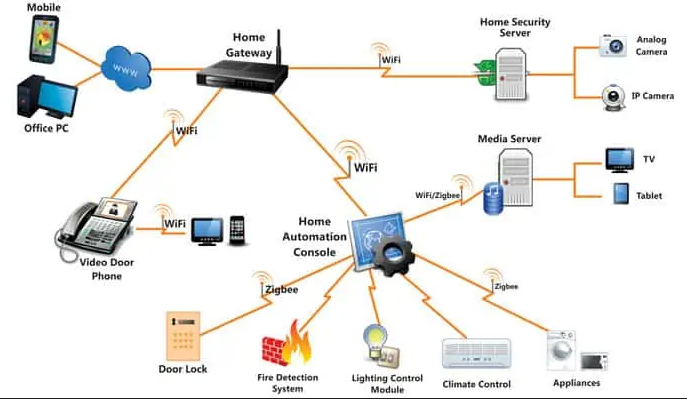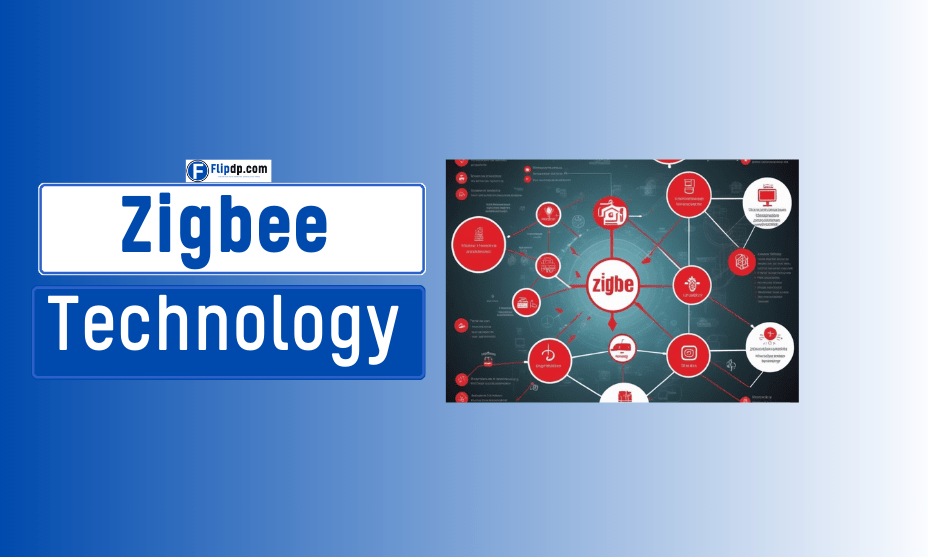Introduction
Zigbee technology has emerged as a vital player in the world of wireless communication, particularly within the realm of the Internet of Things (IoT). As the need for smart homes and interconnected devices continues to grow, understanding Zigbee’s functionality, benefits, and applications becomes essential.
This comprehensive guide delves into Zigbee technology, providing a thorough exploration of its features, advantages, limitations, and real-world applications. Whether you are a technology enthusiast, a developer, or a business owner, this article will equip you with valuable insights into Zigbee technology.
What is Zigbee Technology

Zigbee is a low-power, wireless communication protocol designed for short-range communication, particularly in small networks. Developed in 2002, it enables various devices to communicate and coordinate with each other, forming what is often referred to as a “mesh network.”
Unlike Wi-Fi or Bluetooth, Zigbee is specifically optimized for low data rates and low power consumption, making it ideal for applications requiring energy efficiency and extended battery life.
Key Features of Zigbee Technology
- Low Power Consumption: Zigbee devices can operate for years on a small battery, making it suitable for remote sensors and devices that require infrequent communication.
- Mesh Networking: Zigbee networks can be expanded easily by adding new devices, allowing for robust communication and improved range. Each device acts as a repeater, enhancing the network’s coverage.
- Secure Communication: Zigbee incorporates advanced encryption protocols, ensuring that data transmitted over the network remains secure from unauthorized access.
- Interoperability: Zigbee supports a variety of devices from different manufacturers, allowing seamless integration within smart home ecosystems.
- Low Latency: Zigbee technology ensures fast communication between devices, making it ideal for applications where quick responses are essential.
Understanding the Zigbee Protocol

Zigbee operates on the IEEE 802.15.4 standard, which defines the physical and MAC (Media Access Control) layers for low-rate wireless personal area networks (LR-WPANs). This standard provides the foundational communication protocols that Zigbee builds upon.
Zigbee Architecture
Zigbee networks can be categorized into three main device types:
- Coordinator: The coordinator is responsible for managing the network, including device registration and network address assignment. Each Zigbee network has one coordinator.
- Router: Routers extend the range of the network by relaying messages between devices. They help maintain connectivity and enhance network robustness.
- End Device: End devices are typically battery-operated devices that communicate with routers or coordinators. They can be sensors, switches, or other smart devices.
Zigbee Topologies
Zigbee supports several network topologies, including:
- Star Topology: All devices communicate directly with the coordinator, suitable for smaller networks.
- Mesh Topology: Devices communicate with one another, allowing for greater range and reliability.
- Cluster Tree Topology: A combination of star and mesh, where end devices communicate with routers, which in turn communicate with the coordinator.
Applications of Zigbee Technology

Zigbee technology has found applications across various industries, particularly in smart home automation, healthcare, agriculture, and industrial IoT. Here are some prominent use cases:
1. Smart Home Automation
Zigbee technology is widely used in smart home devices, enabling seamless communication between various gadgets. Examples include:
- Smart Lighting: Zigbee-enabled light bulbs can be controlled remotely, allowing homeowners to adjust brightness or color settings through a mobile app.
- Smart Thermostats: Zigbee-based thermostats optimize heating and cooling by communicating with other devices to learn user preferences.
- Home Security: Zigbee sensors and cameras can be integrated into a home security system, providing real-time alerts and remote monitoring capabilities.
2. Healthcare Applications
In healthcare, Zigbee technology facilitates the monitoring of patients’ vital signs and medication adherence. Examples include:
- Remote Patient Monitoring: Wearable devices equipped with Zigbee technology can transmit data such as heart rate and blood pressure to healthcare providers for analysis.
- Smart Medication Dispensers: Zigbee-enabled dispensers can remind patients to take their medications and alert caregivers in case of missed doses.
3. Agricultural Solutions
Zigbee technology can enhance agricultural practices by enabling smart farming solutions. Examples include:
- Soil Monitoring: Sensors that measure soil moisture and temperature can transmit data to farmers, allowing for informed irrigation decisions.
- Livestock Tracking: Zigbee-enabled collars can monitor the health and location of livestock, improving management efficiency.
4. Industrial IoT
Zigbee is increasingly being adopted in industrial settings for applications such as:
- Asset Tracking: Zigbee devices can track equipment and assets in real time, reducing loss and improving inventory management.
- Predictive Maintenance: Sensors can monitor equipment performance, allowing for timely maintenance and minimizing downtime.
Advantages of Zigbee Technology
Zigbee technology offers several advantages that make it a preferred choice for various applications:
- Energy Efficiency: Zigbee devices consume minimal power, making them ideal for battery-operated devices that require long operational life.
- Scalability: The mesh network architecture allows for easy expansion by adding new devices without significant changes to the existing infrastructure.
- Cost-Effectiveness: Zigbee’s low power and simple implementation lead to reduced costs, making it an attractive option for both manufacturers and consumers.
- Robustness: The mesh networking feature ensures that if one device fails, others can still communicate, enhancing overall network reliability.
Challenges and Limitations of Zigbee Technology
Despite its many advantages, Zigbee technology faces some challenges and limitations:
- Limited Bandwidth: Zigbee’s low data rate (typically 20-250 kbps) makes it unsuitable for applications requiring high bandwidth, such as video streaming.
- Interference: Zigbee operates in the 2.4 GHz frequency band, which is crowded with other devices (e.g., Wi-Fi, Bluetooth). This can lead to interference and impact performance.
- Network Range: While Zigbee supports long-range communication through mesh networking, the effective range can still be limited by obstacles such as walls and floors.
- Complexity of Integration: Integrating Zigbee devices from different manufacturers can sometimes lead to compatibility issues, requiring careful consideration during deployment.
Comparing Zigbee with Other Wireless Technologies
To fully appreciate Zigbee technology, it’s essential to compare it with other wireless communication technologies like Wi-Fi, Bluetooth, and Z-Wave.
Zigbee vs. Wi-Fi
- Power Consumption: Zigbee consumes significantly less power compared to Wi-Fi, making it ideal for battery-operated devices.
- Range: Zigbee has a shorter range than Wi-Fi, but its mesh networking capabilities can extend coverage effectively.
- Data Rate: Zigbee offers lower data rates than Wi-Fi, making it suitable for applications with minimal data transmission needs.
Zigbee vs. Bluetooth
- Network Size: Zigbee can support a larger number of devices in a network compared to Bluetooth, which is typically limited to a few paired devices.
- Power Consumption: Both Zigbee and Bluetooth are low-power technologies, but Zigbee is optimized for even lower energy use.
- Latency: Zigbee generally has lower latency compared to Bluetooth, making it better for real-time applications.
Zigbee vs. Z-Wave
- Frequency: Zigbee operates in the 2.4 GHz band, while Z-Wave operates in sub-GHz frequencies (e.g., 908.42 MHz in the US). This can influence range and interference levels.
- Interoperability: Zigbee boasts broader interoperability among various devices from different manufacturers, whereas Z-Wave is more limited.
- Data Rate: Zigbee offers higher data rates than Z-Wave, making it better suited for applications with higher data transmission requirements.
Future of Zigbee Technology
As the demand for smart devices and interconnected systems continues to rise, Zigbee technology is poised for growth. The development of Zigbee 3.0, which unifies previous Zigbee specifications, is a significant step toward improving compatibility and interoperability among devices. This unified standard is expected to facilitate the adoption of Zigbee in new applications, including smart cities, industrial automation, and enhanced home automation systems.
Emerging Trends
- Integration with Other Technologies: Zigbee is increasingly being integrated with other wireless technologies (such as Wi-Fi and cellular networks) to enhance functionality and reach.
- Increased Focus on Security: As cyber threats continue to rise, the development of more robust security protocols within Zigbee networks is essential.
- Smart Home Ecosystems: The growth of smart home ecosystems, such as Amazon Alexa and Google Home, will drive demand for Zigbee-enabled devices, enhancing their market presence.
Conclusion
In conclusion, Zigbee technology plays a pivotal role in enabling efficient, low-power wireless communication in various applications, from smart home automation to industrial IoT solutions. Its energy efficiency, scalability, and security features make it an attractive option for manufacturers and consumers alike.
Despite some limitations, the future of Zigbee looks promising as it continues to evolve and adapt to the growing demands of a connected world. By understanding Zigbee technology and its applications, you can make informed decisions about integrating it into your projects and everyday life.
FAQs, Zigbee Technology
1. What is Zigbee technology?
Zigbee is a wireless communication protocol designed for low-power, low-data-rate applications. It operates on IEEE 802.15.4 standards, enabling devices to communicate over short distances (typically up to 100 meters) while maintaining energy efficiency, making it ideal for applications like smart home devices, industrial automation, and health monitoring systems.
2. How does Zigbee work?
Zigbee operates in a mesh networking configuration, allowing devices to communicate with each other directly or indirectly through intermediate nodes. This means that even if a device is out of range from the main hub, it can still send data by relaying through other devices, enhancing coverage and reliability.
3. What are the key features of Zigbee?
Some key features of Zigbee include:
Low power consumption: Designed for devices that require long battery life.
Mesh networking: Enhances range and reliability through device interconnectivity.
Low data rates: Suitable for applications that do not require high bandwidth.
Robust security: Offers features like encryption and authentication to protect data.
4. What are the typical applications of Zigbee?
Zigbee is commonly used in various applications, including:
Smart home devices (lights, thermostats, and security systems)
Industrial automation and control systems
Healthcare monitoring devices
Smart grid and energy management systems
5. How does Zigbee compare to other wireless technologies like Wi-Fi and Bluetooth?
Zigbee differs from Wi-Fi and Bluetooth in several ways:
Range and power: Zigbee has a shorter range but consumes less power, making it ideal for battery-operated devices.
Data rate: Zigbee supports lower data rates compared to Wi-Fi, which is better suited for high-bandwidth applications.
Network structure: Zigbee uses a mesh network, while Wi-Fi typically uses a star topology, which affects how devices communicate and extend their coverage.











